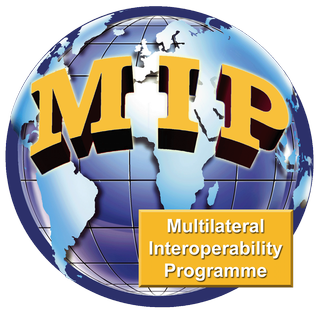Related Research Articles

The Defense Information Systems Agency (DISA), known as the Defense Communications Agency (DCA) until 1991, is a United States Department of Defense (DoD) combat support agency composed of military, federal civilians, and contractors. DISA provides information technology (IT) and communications support to the President, Vice President, Secretary of Defense, the military services, the combatant commands, and any individual or system contributing to the defense of the United States.

In current military use, combined operations are operations conducted by forces of two or more allied nations acting together for the accomplishment of a common strategy, a strategic and operational and sometimes tactical cooperation. Interaction between units and formations of the land, naval and air forces, or the cooperation between military and civilian authorities in peacekeeping or disaster relief operations is known as joint operations or interoperability capability.

United States Joint Forces Command (USJFCOM) was a Unified Combatant Command of the United States Department of Defense. USJFCOM was a functional command that provided specific services to the military. The last commander was Army Gen. Ray Odierno. As directed by the President to identify opportunities to cut costs and rebalance priorities, Defense Secretary Robert Gates recommended that USJFCOM be disestablished and its essential functions reassigned to other unified combatant commands. Formal disestablishment occurred on 4 August 2011.
Network-centric warfare, also called network-centric operations or net-centric warfare, is a military doctrine or theory of war that seeks to translate an information advantage, enabled in part by information technology, into a competitive advantage through the robust computer networking of well informed geographically dispersed forces. It was pioneered by the United States Department of Defense in the 1990s.

Allied Command Transformation (ACT) is a military command of the North Atlantic Treaty Organization (NATO), formed in 2003 after restructuring.
The Combined Communications-Electronics Board (CCEB) is a five-nation joint military communications-electronics (C-E) organisation whose mission is the coordination of any military C-E matter that is referred to it by a member nation. The member nations of the CCEB are Australia, Canada, New Zealand, the United Kingdom and the United States. The CCEB is the Sponsoring Authority for all Allied Communications Publications (ACPs). ACPs are raised and issued under common agreement between the member nations. The CCEB Board consists of a senior Command, Control, Communications and Computer (C4) representative from each of the member nations.

The Allied Air Command (AIRCOM) is the central command of all NATO air and space forces and the Commander Allied Air Command is the prime air and space advisor to the Alliance. When directed by the Supreme Allied Commander Europe (SACEUR), it provides the core of the headquarters responsible for the conduct of air operations. The command is based at the Ramstein Air Base in Germany.

The Multilateral Interoperability Programme (MIP) is an effort to deliver an assured capability for interoperability of information to support multinational, combined and joint operations. The MIP goal is to support all levels from corps to battalion. MIP's focus is on command and control systems. MIP is a consortium of 29 NATO and Non-NATO nations that meet quarterly to define interoperability specifications for the exchange information between their national Command and Control systems.

The Estonian Defence Forces is the unified armed forces of the Republic of Estonia. The Estonian military is a defence force consisting of Land Forces, Navy, Air Force, and a paramilitary Defence League. The national defence policy aims to guarantee the preservation of the independence and sovereignty of the state, the integrity of its land area, territorial waters and airspace and its constitutional order. Its main goals remain the development and maintenance of a credible capability to defend the nation's vital interests and development of the defence forces in a way that ensures their interoperability with the armed forces of NATO and European Union member states to participate in the full range of missions for these military alliances.

PM WIN-T is a component of Program Executive Office Command, Control and Communications-Tactical in the United States Army. PM WIN-T has been absorbed into PM Tactical Networks as Product Manager for Mission Networks.
AUSCANNZUKUS is an abbreviation for the naval Command, Control, Communications and Computers (C4) interoperability organization involving the Anglosphere nations of Australia, Canada, New Zealand, the United Kingdom, and the United States. It is also used as security caveat in the UKUSA Community, where it is also known as "Five Eyes".

The NATO Communications and Information Agency is NATO's technology and cyber hub.

Project Manager Mission Command is a component of Program Executive Office Command, Control and Communications-Tactical in the United States Army. PM MC develops, deploys and sustains integrated Mission Command software capabilities to the Army and Joint forces. PM MC’s support ensures tactical and other unit types are efficiently fielded, effectively trained and professionally supported. Product lines include the areas of maneuver, fires, sustainment, and infrastructure.
A battle lab or battle laboratory is an organization dedicated to studying changes in the military.

Saber Strike is an annual international exercise held since 2010 by the United States Army Europe (USAREUR) focused on the Baltic States. The exercise spans multiple locations in Lithuania, Latvia and Estonia and involves approximately 2,000 troops from 14 countries.

The Joint Deployable Analysis Team (JDAT) is part of the J6 Directorate of the Joint Chiefs of Staff.

Federated Mission Networking (FMN) is a significant initiative to help ensure interoperability and operational effectiveness of the North Atlantic Treaty Organization, it is a key contribution to the Connected Forces Initiative, helping Allied and Partner forces to better communicate, train and operate together. This includes the NATO Command Structure as well as the NATO Force Structure. The purpose of FMN is ultimately to support Command, Control, Communications, Computers, Intelligence, Surveillance and Reconnaissance (C4ISR) and decision-making in operations by enabling a rapid instantiation of mission networks. Including the NATO Command Structure, 35 nations have joined the FMN initiative as so called "FMN Affiliates" and work together under the FMN Framework Process to coordinate the design, development and delivery of operational and technical capabilities required to conduct net-centric operations. Each development increment is referred to as an "FMN Spiral". The respective requirements, architecture, standards, procedural and technical instructions are documented in so called "FMN Spiral Specifications". FMN Spiral Specifications are based on well known standards and best practices, hence supported by most off-the-shelf products and vendor neutral. TACOMS standards and profiles specify a common, technology and topology independent network interoperability layer for federated mission networks. There is also a rolling 10-year FMN Spiral Specification Roadmap of the envisioned future capabilities. At the same time, the Coalition Interoperability Assurance and Validation (CIAV) process ensures that current interoperability issues are being identified and fed back into FMN capability development.
The Afghanistan Mission Network (AMN) is the primary Coalition, Command, Control, Communications, Computers, Intelligence, Surveillance, and Reconnaissance (C5ISR) network for NATO-led missions in Afghanistan. By providing a common network over which to share critical information, the AMN enabled a shift in information-sharing posture from "need to know" to "need to share," resulting in an increase in situational awareness among coalition partners. AMN establishes a common information sharing platform that provides standardised services such as email, instant messaging or chat, Common Operational Picture service, VTC, Voice over IP and Web Services for document sharing and application integration to all coalition participants. The effort generated invaluable lessons in how to approach coalition networking in future operations. Based on those lessons learned with AMN, NATO is institutionalising this approach under the Federated Mission Networking initiative.
This articles outlines the defence forces of the European Union (EU), which implement the EU's Common Security and Defence Policy (CSDP) in CSDP missions. There are two categories of EU multinational forces: ones that have been established intergovernmentally and made available to the CSDP through article 42.3 of the Treaty on European Union (TEU), such as the Eurocorps; and the EU Battlegroups, established at the EU level.
References
- ↑ DISA.mil: Multinational Information Sharing (MNIS)
- ↑ CFBLNet 2006 Annual Report, page 7.